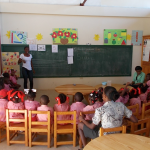
Edysson
All the children at ADECA are special, and they all have special needs. But none of them is like Edysson. He’s the son of Wanna, a single mother from Mariaman. Edysson’s father abandoned Wanna before he was born.
Wanna grew up as one of her mother’s ten children, and she had little opportunity to go to school herself. But she was determined that things would be different for her kids. She sent her first child, Marie Kerline, to a kindergarten down in Bois Moquette as soon as the girl was old enough. She had moved into an aunt’s home near Bois Moquette when Edysson was about two.
But Edysson was different. He was born with challenges both to body and to soul. He’s club footed, and at birth one of his feet was twisted inward nearly ninety degrees. His godfather, Wanna’s younger brother Eddy, had heard from a friend about a clinic in Pétion-Ville that was opened after the earthquake. It would mean a lot of hiking up and down the hill with the boy, but he’d get braces for his leg for nothing. Even so, Edysson was still struggling to walk when he turned five.
And that wasn’t the worst of it. Edysson didn’t speak. A visitor to ADECA has since suggested that he may be autistic, but all his mother knew was that he isn’t like other kids. The only word he had learned to say, more or less, at the time was one of the ugliest swear words in the Haitian language. Children like Edysson face grim futures in Haiti. The lack of understanding of their situation can lead to lives full of neglect and even abuse.
Her friends tried to tell her that she couldn’t send a boy like Edysson to school. He couldn’t walk or talk. “Everyone tried to discourage me, but I wouldn’t listen.” A friend told her about the new school in Ba Osia, so she decided to try to sign Edysson up. She asked the friend to take Edysson and send him to school for her, but heard that she would have to volunteer at the school four hours every week. “So I decided to move back up the hill with Marie Kerline and Edysson.”
She got to registration early, but there was already a long line. “Everyone in line told me that the school would never take Edysson. Some said that he couldn’t talk. Others said that he was already too old. I just ignored them and waited my turn. I made sure I had everything I needed: All of Edysson’s papers and exact change for the registration fee.”
That was last year, and Edysson was in school. Because of his advanced age, he placed immediately into ADECA’s second-year class with Francesse as his main teacher. “I wasn’t sure what we’d do with him. He never spoke except to swear at the other children. Most of the time he was silent. And he wouldn’t even look at you. The last school I worked at never would have taken a child like him. But when Alex told me he’d be in my class, I figured I’d just have to deal with it.”
They first saw how hard it was for him to walk. Even getting to school was challenging, because he was getting big enough that Wanna had a hard time carrying him. “I saw he loved playing with the soccer ball,” Francesse explains. “So we’d just throw the ball to him and let him run after it. At first, he would stumble and fall pretty often. But he’d get up and keep running. And the more he’d run, the better he got. Now he walks without difficulty.”
Including Edysson in the classroom, however, has been much harder than helping him learn to walk. But Francesse soon made a discovery. She noticed that he likes to copy what the other kids are doing. She would make him sit next to her in the circle, so she could keep a close eye on him, and just let him try to do whatever work the other kids were doing. “He especially likes to draw and paint.”
He’s made little progress in the year and a half that he’s been in the class, but it’s progress nonetheless. “He used to just scribble with the colored pencils any old way. Now he has better control of his hand. When we ask him to color something in, he can stay mostly within the lines.”
What might have seemed the most difficult challenge has turned out to be the easiest of all. Francesse wasn’t sure how she would integrate Edysson socially with the other kids. “I wanted everyone to see him as a child just like all the rest.” But integrating a boy who could say little except the Haitian equivalent of “#@%& your mother” to other children, and who could be violent at times, might have seemed hard. “He has sharp teeth. When he bites, it really hurts.”
“But the children learned to accept him on their own. They gradually stopped annoying him. And whenever he would get restless, I learned to settle him down by letting him color next to me. Now if two of the kids get into an argument, one will run up to Edysson and get him to swear at the other child. He’s learned to say ‘A’, ‘O’, and ‘I’, but he can also say the name of one of the other boys, who is his closest friend.”
It is hard to foresee how Edysson will move forward. But thanks to his mother’s determination, his teacher’s patience, and to ADECA, he has a chance that few Haitian children like him would ever have.







